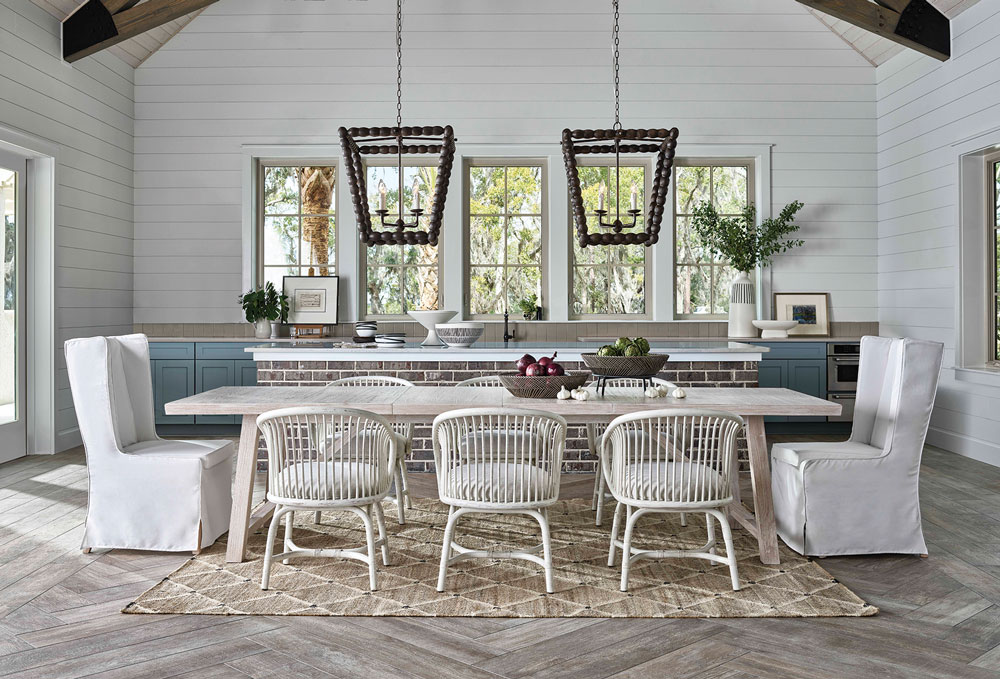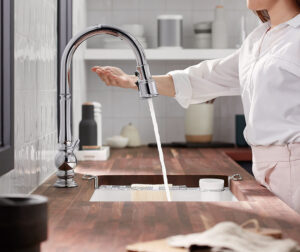10 Tips for Designing a Healthy Home
Writer Meg Fox | Designer Terri Fiori, Allied ASIDCreate spaces that calm, nourish and restore

Use of natural materials, warm wood tones, live plants and tactile textures brings the outdoors in. (Getaway dining table & Aruba Rattan Chairs, www.UniversalFurniture.com)

Terri Fiori, Allied Member ASID; CAPS Principal, Fiori Interior Design, LLC Wyckoff | 201-848-9797 FioriInteriorDesign.com
Designing homes to improve health, mind and well-being is essential — perhaps now more than ever. For designer Terri Fiori — principal of Fiori Interior Design in Wyckoff — a healthy home is one that nurtures your soul, allows you to connect with your family and yourself, and is a place of inspiration.
“When you live in a beautifully designed home that is created just for you, your environment gives back to you ten-fold,” the designer says. What elements impact our quality of living? Fiori breaks it down into 10 all-encompassing components:

Touchless, sensor-operated faucets conserve water, are easy to use and contribute to a higher level of hygiene. (Kohler Artifacts® Single Handle Sensor Kitchen Faucet, www.FergusonShowrooms.com)
1 | Quality of Light
If your home doesn’t allow for natural light, there are ways to lighten up your space creatively. My number one tip is always layer your lighting from the top down. A chandelier draws people into your space; table lamps are great for task lighting and make a room feel cozier; directed light from picture lighting or sconces creates visual interest.
2 | Color Psychology
Not to oversimplify how color can guide our emotions, but less saturated colors — ones that are in the cool family like purple, blue and green — will make a space more peaceful and less anxiety provoking. These colors have healing and calming influences and are generally stress reducing. Warm colors like red, orange and yellow are exciting and can increase blood pressure. Home offices and dining rooms are candidates for spaces like these.
3 | Space & Furniture Arrangement
Circular seating arrangements in a living area encourage conversation. Lightweight pieces that can be arranged and rearranged with ease also offer greater flexibility.
4 | Materials, Textures & Patterns
Adding materials or textures like a natural wood grain is a stress reducer. It’s been proven to have the same effect as if you’re looking at a nature scene. Consider adding a wood beam in a room; bringing in wood bar stools to an all-white kitchen; or installing a wood countertop instead of granite.
5 | Visual Variety
Seeing your favorite objects can boost your mood, support better problem solving and enhance creative thinking. So dust off your most meaningful objects, arrange them in evocative groupings and put them in a place where you and your guests can view them.
6 | Sensory Perception
This could be the most simple and cost-effective mood- boosting tip. Choosing the scent of sweet orange and layering in the aroma of vanilla is an anxiety reducer. The smell of jasmine has the same effect on people as prescription medications that reduce anxiety. And Yogis know that the smell of burning frankincense reduces anxiety and depression. You can obtain any of those scents with candles or aromatherapy.
7 | Sound Effects
If you’re remodeling your home and noise is an issue, consider using double paned-glass windows. Covering your ceiling — with rustic wood or a soft material like wallpaper — is another sound-proofing measure. So are window treatments made from thicker textiles like wool or walls upholstered in fabric.
8 | Sustainability Factor
For starters, improve a home’s air quality by using wool carpeting, which is a natural fiber that is bio-degradable, rapidly renewable and moisture and water resistant, if left untreated. By contrast, nylon and polyester carpets are made from petrochemicals that pollute the environment. Use products that release low VOCs (Benjamin Moore Aura paints, are one example). Look for furniture that doesn’t use toxic glues; use air systems that bring refreshing outdoor air indoors; and select mold and mildew-resistant insulation.
9 | Biophilic Design
Plants improve a home’s air quality. Their presence also increases the humidity, which could influence mucous membrane systems and filter the effects of airborne chemicals.
10 | Livable aka Universal Design
You can add a few alterations that are simple and intuitive to create a safer, barrier-free environment. For starters, consider lever handles, non-skid floors, motion-sensored lighting, touchless faucets and stylish grab bars.
